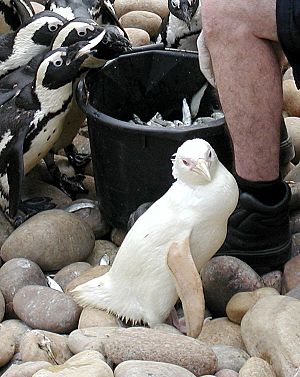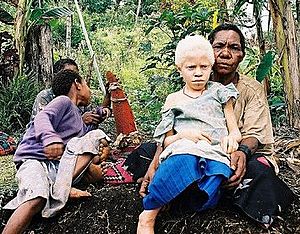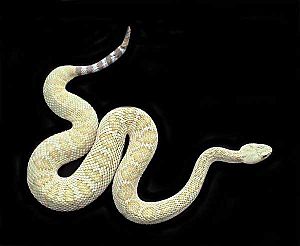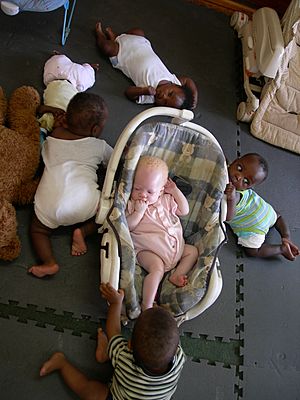Albinism facts for kids

Albinism is a special condition that some people and animals are born with. It means their bodies don't make enough pigment, which is the natural colour found in their hair, eyes, and skin. A person or animal with albinism is called an albino. However, many people with albinism prefer to be called "a person with albinism." There are different kinds of albinism.
People with albinism often have white or very light blonde hair. Their skin can be very pale. Their eyes might be blue, or sometimes look pink-ish. People with albinism can have challenges like not seeing very well. They also get sunburnt easily because they have less colour in their skin, hair, and eyes.
Albinism is not very common. For example, in the United States, about 1 in 20,000 people have albinism. This means around 15,945 people in the U.S. have this condition.
People with albinism can have vision problems. Their eyes might make fast, shaky movements, which is called nystagmus. Sometimes their eyes don't line up correctly, known as strabismus. They might also be near-sighted or far-sighted.
For albino animals, life can be harder in the wild. They are easier for predators to spot. This is because they don't have the natural camouflage that other animals of their kind have. Also, if colour is important for finding a mate, they might have trouble finding one.
Contents
How Albinism is Passed Down
Albinism is a hereditary condition. This means it is passed down from parents to children through genes. It usually follows a recessive pattern. This means a child must get the albinism gene from both parents to have the condition.
Parents pass on pairs of genes to their children. One pair of genes controls how much melanin (colour pigment) the body makes. If both genes in this pair are not working correctly, then very little or no pigment is made. If only one gene is flawed, the body can still make pigment.

Melanin is a natural pigment that creates most of the colour we see in mammals. There are two main types of melanin. Eumelanin makes dark colours like browns and blacks. Pheomelanin makes lighter colours like reddish tans and blondes. These pigments work together to create different coat colours.
Melanin is made in special cells called melanocytes. This process involves an important enzyme called tyrosinase. Mammals have a gene, called the TYR gene, that tells cells how to make tyrosinase. If this gene is changed or damaged, melanin cannot be made properly, and the mammal will be an albino.
Other genes can also cause albinism. This is because many different hormones and proteins are involved in making melanin. All the genetic traits for albinism are recessive. This means their effect is hidden if they are paired with a stronger, non-albino gene. For albinism to show up, an animal must get a recessive gene from both its mother and its father.
Albinism happens in many different kinds of animals. In North America, at least 300 species have had at least one albino animal reported. Albinism happens in about 1 out of every 10,000 mammal births. However, it is more common in birds, happening in about 1 out of every 1,764 births.
Albinism is most often seen in birds, reptiles, and amphibians. It is less common in mammals and other species. Some animals, like white peacocks or swans, are not true albinos. They have white feathers or fur because of a different gene, not because they lack melanin. Their eyes are usually not red.
Melanin is important for the normal growth of different parts of the eye. This includes the iris, retina, eye muscles, and optic nerve. Without melanin, these parts of the eye don't develop normally. This can lead to problems with focusing and seeing depth.
The eyes of albino animals often look red. This is because the colour of the red blood cells in the retina can be seen through the iris. The iris has no pigment to hide the blood vessels. Some albino animals might have pale-blue eyes due to other colour-making processes.
Melanin also helps protect the skin from ultraviolet radiation from sunlight. It blocks harmful rays from the sun.
Scientists often use albino animals in studies and experiments. Examples include the BALB/c mouse and certain types of Wistar and Sprague Dawley rats. Albino laboratory rabbits are also used.
Albino dolphins were first seen in the Gulf of Mexico in 1962. Since 1994, three more have been spotted. These dolphins often look pink because their blood vessels show through their unpigmented skin.
Albinism in Plants
Plants that look pale because they can't make chlorophyll are sometimes called albinos. Chlorophyll is what makes plants green. If a plant is pale just from being in the dark, it's called etiolated. An albino redwood is a rare example of an albino tree. It has white needles instead of green ones. Even without chlorophyll, it can grow very large. It does this by being a parasite, usually on the base of a normal redwood tree. Only about sixty albino redwoods are known.
Albinism in Human Culture
The Albino Squirrel Preservation Society was started at the University of Texas at Austin in 2001. Members at the University of North Texas even tried to make their albino squirrel a secondary mascot. The University of Louisville in Kentucky also has many albino squirrels.
Albino animals are often kept as pets. Some examples include African clawed frogs, guinea pigs, and peacocks.
Famous People with Albinism
- Edgar Winter - musician
- Johnny Winter - musician
- Salif Keita - musician
Images for kids
-
"Snowflake", a blue-eyed western lowland gorilla with Type IV oculocutaneous albinism
-
An albino killer whale
-
Albino giant gourami
-
Wood Frog with albinism
-
Normal (left) and albino (right) forms of the land snail Pseudofusulus varians
See Also
 In Spanish: Albinismo para niños
In Spanish: Albinismo para niños



















